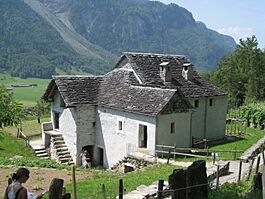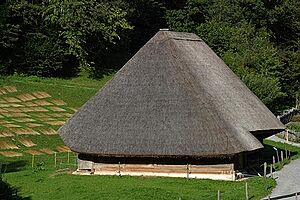Hofstetten bei Brienz facts for kids
Quick facts for kids
Hofstetten bei Brienz
|
||
|---|---|---|

A Ticino style farm house at the Ballenberg Museum, which is partly in Hofstetten bei Brienz
|
||
|
||
| Country | Switzerland | |
| Canton | Bern | |
| District | Interlaken-Oberhasli | |
| Area | ||
| • Total | 8.77 km2 (3.39 sq mi) | |
| Elevation | 646 m (2,119 ft) | |
| Population
(Dec 2020 )
|
||
| • Total | 531 | |
| • Density | 60.55/km2 (156.82/sq mi) | |
| Postal code |
3858
|
|
| Surrounded by | Giswil, Lungern, Brienzwiler, Brienz and Schwanden bei Brienz | |
Hofstetten bei Brienz is a small town, also called a municipality, located in the canton of Bern in Switzerland. It's part of the Interlaken-Oberhasli administrative district.
Contents
What's in a Name?
The name Hofstetten comes from an old German word, hovastat. This word means "a place where a building will be started." In Swiss German, people often say "Hostet" for Hofstetten.
A Look Back in Time: History
Hofstetten bei Brienz was first mentioned in history in 1359. At that time, it was given to a place called Interlaken Monastery. It stayed under the monastery's control until 1528.
In 1528, the city of Bern changed its official religion to Protestantism. This meant the monastery lost its power and land, and Hofstetten became part of Bern's control.
For a long time, the people of Hofstetten mainly farmed and herded animals in the mountains. But in the 1800s, wood carving became a new way to earn money. Today, many people work in woodworking or in tourism. About two-thirds of the working people travel to nearby towns like Brienz or Meiringen for their jobs.
The biggest employer in Hofstetten is the Ballenberg Open Air Museum. This museum opened in 1978 and shows what traditional Swiss life was like.
Exploring the Land: Geography
Hofstetten bei Brienz is located in the beautiful Bernese Oberland region of the Alps. The Aare River flows along the southern edge of the town. You can also find a small body of water called Lake Wyssen a bit higher up in the south.
While the main town is about 580 meters (1,900 feet) above sea level, the land gently rises to the north. Here, you'll find tall peaks like Arnihaaggen (2,207 meters or 7,241 feet), Höch Gumme (2,205 meters or 7,234 feet), and Wilerhorn (2,005 meters or 6,578 feet). The area below these peaks is known as Gummenalp. It includes small settlements like Dorf, Schried, Beim Tor, and Talgut.
Hofstetten bei Brienz covers an area of 8.7 square kilometers (3.4 square miles). A large part of this land, about 29.5%, is used for farming. Forests cover about 43.4% of the area. Buildings and roads take up about 4.5% of the land. Rivers and lakes make up 1.6%, and the rest, about 20.4%, is land that can't be used for farming or building, like rocky areas.
In 2010, Hofstetten bei Brienz joined a new administrative area called Verwaltungskreis Interlaken-Oberhasli.
Town Symbol: Coat of Arms
The coat of arms for Hofstetten bei Brienz has a special design. It shows a green background with a wavy silver stripe. On either side of the stripe, there is a golden star and a golden mill wheel.
Who Lives Here? Demographics
Hofstetten bei Brienz has a population of about 569 people (as of December 2010). A small part of the population, about 6.7%, are people from other countries.
Most people in Hofstetten bei Brienz speak German as their main language (about 95.8%). A few people also speak Italian or Portuguese.
In 2010, about 22.1% of the population were children and teenagers (0–19 years old). Adults (20–64 years old) made up 57.6%, and seniors (over 64 years old) were about 20.2%.
The chart below shows how the population of Hofstetten bei Brienz has changed over many years:

Important Cultural Sites
The Schweizerisches Freilichtmuseum Ballenberg, or Ballenberg Open Air Museum, is a very important place. It is listed as a Swiss heritage site of national significance. This means it's a special place that is protected and valued for its history and culture.
How People Make a Living: Economy
In 2011, the unemployment rate in Hofstetten bei Brienz was quite low, at 1.54%. This means most people who wanted to work had jobs.
In 2008, there were 313 people working in the town. These jobs can be divided into three main groups:
- Primary sector: This includes jobs like farming and forestry. About 32 people worked in this area.
- Secondary sector: These are jobs where people make things, like in factories or construction. About 78 people worked in this sector.
- Tertiary sector: This includes jobs that provide services, like working in shops, hotels, restaurants, education, or healthcare. About 203 people worked in this sector.
Many people who live in Hofstetten bei Brienz travel to other towns for work. In 2000, 183 people left the town for their jobs, while 62 people came into Hofstetten for work. Most people (50.2%) used a private car to get to work, while 11.8% used public transportation.
Beliefs and Faith: Religion
In 2000, most people in Hofstetten bei Brienz belonged to the Swiss Reformed Church (about 74%). A smaller number were Roman Catholic (about 11.8%). There were also people who belonged to other Christian churches, as well as a few who were Islamic, Buddhist, or Hindu. Some people did not belong to any church.
Learning and Schools: Education
In Hofstetten bei Brienz, many adults have completed upper secondary education, which is like high school. Some have also gone on to higher education at a university or a specialized college.
The Canton of Bern has a school system that starts with one year of non-required Kindergarten. After that, students go to six years of Primary school. Then, they have three years of lower Secondary school, where students are grouped by their abilities. After secondary school, students can continue their education or start an apprenticeship to learn a trade.
During the 2010-2011 school year, there were 164 students in Hofstetten bei Brienz. There were two kindergarten classes with 35 students. The town also had six primary classes with 94 students and two lower secondary classes with 35 students.
See also
 In Spanish: Hofstetten bei Brienz para niños
In Spanish: Hofstetten bei Brienz para niños






